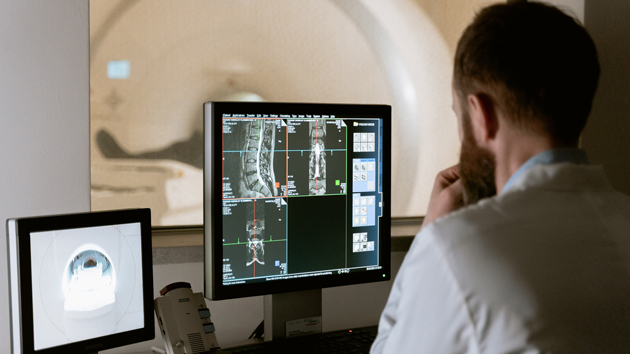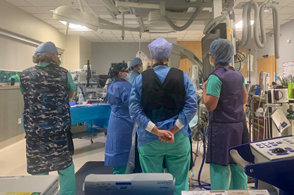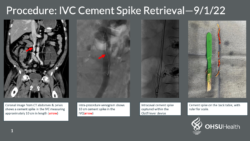
Hillsboro Medical Center is proud to announce our newly launched Interventional Radiology services in partnership with the Dotter Department of Interventional Radiology at Oregon Health & Science University.
Our team of interventional radiologists use imaging technologies as a guide to deliver treatment to targeted vessels, organs and cavities in the body.
These minimally invasive procedures are generally low risk, can minimize pain and help reduce recovery time compared to traditional surgery.
Through our partnership with OHSU, the original pioneers of interventional radiology, we are able to provide our patients with cutting-edge care conveniently close to home.
Learn more about our services from Hillsboro Medical Center’s Interventional Radiology Medical Director, Dr. Masahiro Horikawa, and interventional radiologist Dr. Ryan Meek.
Q: What is interventional radiology?
Dr. Meek: In interventional radiology, we use a lot of different imaging modalities—such as X-rays, MRIs and CT scans—to guide wires, needles and catheters throughout the body to deliver treatment.
This allows us to reach specific vessels, organs and cavities in the body, and enables us to treat a broad spectrum of illnesses. We can conduct everything from dialysis access interventions to interventional oncology.
Dr. Horikawa: We’re in fact able to perform 200 different procedures using imaging modalities as our navigation. Our scope of practice is essentially any part of the body from head to toe.
Q: What led you both into the field of interventional radiology?
Dr. Meek: Really what attracted me to interventional radiology is that it’s a very innovative field where we can perform all kinds of image-guided procedures to treat both simple and complex medical conditions.
Dr. Horikawa: I was born, raised and trained in Japan. When I first saw an interventional radiology procedure, it was as an intern for my patient who had a bleeding inside the abdomen vessel. The interventional radiologist was able to treat the patient with just a catheter. I thought he was a magician!
After spending several years in Japan, I realized that the innovation of interventional radiology was born in Portland at OHSU, so that’s what brought me here nine years ago.

The Interventional Radiology team performs its first procedure at Hillsboro Medical Center.
Q: What are the main benefits of interventional radiology?
Dr. Horikawa: Our navigation is in real time and is very precise. We’re really using the latest technologies and methodologies to provide the most effective procedure possible.
Dr. Meek: Patients will be glad to hear that means there are no big open incisions and that a lot of procedures can be done under moderate sedation without needing a dedicated anesthesiologist.
Another benefit is that the recovery time is much less for patients to deal with so they can get back to what they’re doing much quicker.
Q: What was your first case here at Hillsboro Medical Center?
Dr. Meek: It was a male patient with prostate cancer that had metastasized to his spine. For that he’d previously undergone a procedure at a different hospital where they fused part of the spine with cement augmentation.
When he came to us, a CT scan showed that some of that cement had gone into the lumbar vein and the abdomen. It was a sharp and long spiked fragment measuring about 10 centimeters in length.
Dr. Horikawa: It was at a high risk of breaking off and could have easily pierced his heart.
Fishing the cement out with a snare would have the potential for a broken piece of cement to migrate in his body. So we used a brand new, basket-type device to cover up the entire segment of cement to ensure that nothing escaped out.
Our method allowed us to entirely capture the pierce-like cement. This device had never been used for this exact procedure before.
Dr. Meek: For this case, the alternative option would have been a big surgery with some level of uncertainty and inaccuracy. We were able to perform everything precisely by only inserting two needle holes into the neck and the groin for this procedure.

An overview of Interventional Radiology services’ first procedure at Hillsboro Medical Center.
Q: What types of procedures do you offer?
Dr. Meek: We offer:
- Biliary drain placement/exchange/removal
- Chemo-embolization
- Chest port placement/replacement/removal
- Cholangiogram
- Embolization/UFE/GI-bleed
- Fistulogram
- G/G-J/J-tube placement/exchange/removal
- IVC Filters placement/retrieval
- PICC line placement (if vascular access is unsuccessful)
- Renal artery angioplasty/stenting
- Trans Jugular Liver Biopsy
- Tunneled and non-tunneled dialysis/central line placement/exchange/removal/repair
- Visceral angiogram/angioplasty
Q: What makes Hillsboro Medical Center’s Interventional Radiology services unique?
Dr. Horikawa: Our intention is to provide really high-level, high-quality of care in a more convenient location and familiar environment within your local community.
Learn more about Hillsboro Medical Center’s Interventional Radiology services »
